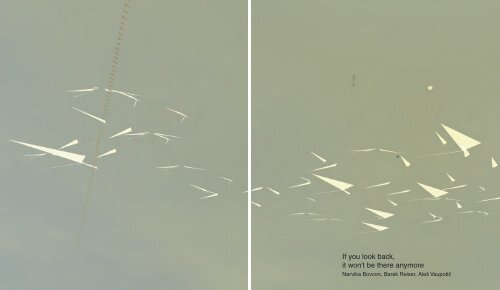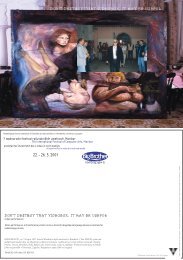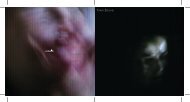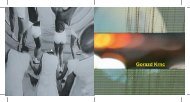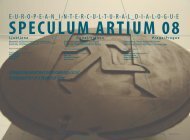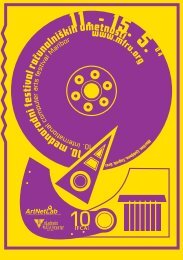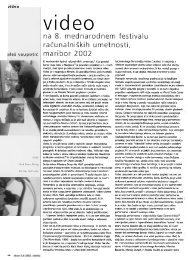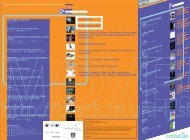Create successful ePaper yourself
Turn your PDF publications into a flip-book with our unique Google optimized e-Paper software.
If you look back,<br />
it won't be there anymore<br />
Narvika Bovcon, Barak Reiser, Aleš Vaupotic<br />
˚<br />
I left the room,<br />
and when I returned, the word “room” was erased from all dictionaries,<br />
and a different word replaced it.<br />
I sat in that different word<br />
and followed its instructions.<br />
Hezy Leskly: from the cycle 'The Room and the World'
1<br />
2<br />
2<br />
3<br />
1<br />
5<br />
initial state - three objects are generated<br />
(black) move to the empty space outside the outer circle,<br />
no object is visited,<br />
(one object remains, two other objects are generated)<br />
1<br />
4<br />
1<br />
2<br />
4<br />
1<br />
5<br />
3<br />
(magenta) again move to empty space<br />
(with the move in this direction two objects remain)<br />
(cyan) move to object 4<br />
4<br />
2<br />
4 4<br />
3<br />
1<br />
3<br />
database example<br />
1 2 3 4 5<br />
5<br />
(green) move to object 3,<br />
objects 3 and 4 are visited and don't reappear until<br />
all the other objects are visited too<br />
dynamic space reading algorithm (top view of the space)<br />
Data Dune<br />
Sketch for the algorithm for the digital desert, the "main space"
If you look back, it won't be there anymore, is a computer-based series of interactive rooms.<br />
How can one construct an entire world using as few elements as possible These elements would have to be linked together<br />
and repeat themselves in various ways, shapes and forms.<br />
In reality, it wouldn't be easy to implement this project as a series of existing rooms. This project deals with the concept of<br />
"installation" as a medium and the manner in which spaces are organized. "Déja-vus", ` "negative/positive" -- the chasm between the<br />
connection between an object and its representation in the form of a model or an image, as well as all possible notions of repetition<br />
are among the thoughts that occur while passing through a system of rooms. Questions regarding the concepts of "space" and of<br />
"virtual space" are among the issues explored by this work.<br />
Virtual reality is one of the aspects of this work. While advancing through the main space occupied by the work, there are<br />
objects that appear randomly. This space is infinite -- in which the transparent dunes move slowly. Mathematically, this space will<br />
never repeat itself in the exact same form. Therefore, no matter how much time one spends in this room, it is constantly changing.<br />
Thus, not all of the objects and elements of the work may appear. Ignoring the objects by not approaching them will prevent them<br />
from appearing.<br />
An additional aspect of these virtual rooms is that they don't obey the rule of gravity. With the help of the mouse or keyboard, the<br />
visitor can rotate his or her view by 180 degrees and travel upside-down.<br />
What is the difference between existing and virtual spaces It is almost like trying to discover precisely what "truth" is. One can<br />
be aware of this question, for example, when viewing any of the news channels on television. Is it CNN This is a channel that brings<br />
us constant "news" from different "worlds." The letters "C" and "N" can be rotated in order to be viewed as the letters "U" and "Z,"<br />
respectively. The possibility of playing with and altering selected elements is what this project is about.<br />
Except for encountering stationary visual elements -- such as video footage of fashion, outer space, a soap opera, shifting<br />
transparent dunes, an antenna, moving objects in the form of the letter "Z," an illuminated object in the shape of a palm tree which is<br />
powered by a solar panel -- the viewers move within these spaces by themselves and may even encounter a flying insect. Upon<br />
entering the lounge, the visitor has an opportunity to see the work's three authors, who are spending some time there as well.<br />
Room list:<br />
1. Main Space<br />
2. White Room<br />
3. Yellow Territory<br />
4. Black Room<br />
5. Triple Room<br />
6. 2020 Rooms<br />
7. Lounge
The project explores the possibilities of dynamic generation of digital spaces. Its interactivity revolves around two axes: the recording<br />
of user's input and the data-streams from the Internet or from an archive. From the opposite angle the concept acts in reverse - the user<br />
of the artistically encoded digital space is faced with hyperspatial text, the text that codes meaning by means of digital perspective<br />
renderings. There are three fundamental layers: the movement of dunes through an infinite space according to a data-flow and<br />
additionally determined by rules (following scientific models of barchan dunes), the repeating square grid of radio stations that stands<br />
for sounds of wind in the desert and the encoding of the narrative within a spatial form. The latter embodies the basic possibility of an<br />
algorithmic discourse, which supplies the user with the data according to his/her actions.<br />
Sketch for the infinite space of the dunes
Sketch for the grid of sounds<br />
The soundtrack in the Main Space is a compilation of the following sound footages:<br />
- Soap Opera<br />
- Fashion Channel<br />
- Modified excerpt from the song "Yellow" by Coldplay from the Album "Parachutes", 2000, track#5<br />
- Blowing wind<br />
- A rolling / falling / spinning coin<br />
- Excerpt of a video sequence documenting an audience watching the 2006 World Cup soccer game between Germany and Argentina
Index of all elements of the work
- Transparent dunes (move throughout the "main space")<br />
- Moving object in the form of the letter Z<br />
- Reflection of the letter Z - the Eastern Gate of Belgrade, a complex of three high-rise residential buildings<br />
- Letter U (appears twice in two colours in the work, once white in the "main space", second time black in the "white room")<br />
- Letter C (appears twice in two colours in the work, once black in the "main space", second time white in the "black room")<br />
- Letter O (by approaching it, one moves to the yellow territory)<br />
- An ultramarine sun (being reflected)<br />
- An antenna, on its top there is the letter N (by approaching it, one moves to the "triple room", covered with the football image)<br />
- An image of a soccer field, central Africa<br />
- A model of the "main space" (shows the structure how the dunes move)<br />
- A hieroglyph of crane birds, taken from the 20-tolar coin - current 2-cent coin<br />
- A 20-tolar coin - current 2-cent coin (by approaching it, one moves to the series of rooms with video footages)<br />
- Video footage from a Latin soap opera<br />
- Video footage from a Fashion TV channel<br />
- Digital video sequences of the evolution of Cosmos by Volker Springel<br />
- Rooms in the shape of 2020<br />
- A Dragonfly<br />
- A lit shape of a palm tree, connected to solar cells (by approaching it, one moves to the lobby, where the authors are sitting)<br />
- Video footage of audience watching the soccer game - Germany vs. Argentina, World Cup 2006, the sound track of the "triple room".<br />
- The "lounge", based on Anton Henning's installation "Frankfurter Salon", Museum für Moderne Kunst, Frankfurt am Main, 2005
Project credits:<br />
Concept, Design: Narvika Bovcon, Barak Reiser, Aleš Vaupotic<br />
Coding (Data Dune 1.0, 1.1): Igor Lautar<br />
Dark matter simulations: Volker Springel, Max Planck Institut für Astrophysik Garching<br />
The Lounge was modelled by Narvika Bovcon and Aleš Vaupotic with the help of:<br />
Marion Baumgartner, Gerald Painsi and Miriam Schneider (EU-NZ Leonardo Exchange),<br />
after Anton Henning's installation "Frankfurter Salon", Museum für Moderne Kunst, Frankfurt am Main, 2005<br />
Production: <strong>ArtNetLab</strong>, Ljubljana, Slovenia, 2005 - 2008<br />
http://black.fri.uni-lj.si<br />
Exhibitions up to 2007:<br />
- "If you look back, it won't be there anymore (Data Dune 1.0)", Heimspiel gallery, Frankfurt am Main, 8 December 2005 (Presentation)<br />
- "If you look back, it won't be there anymore (on the Data Dune 1.1 platform)", Multimedia Centre KIBLA, Maribor, Slovenia, 13 - 23<br />
January 2006, http://www.kibla.org (Solo exhibition)<br />
- "12th International Festival of Computer Arts", City Art Museum Ljubljana, Cyberpipe, Ljubljana, 9 - 12 May 2006<br />
- "<strong>ArtNetLab</strong> Production 2006", MAMA Zagreb, Croatia, 7 June 2006<br />
- "Algorithms of Inclusion", O3ONE Gallery, Belgrade, Serbia, 14 - 17 March 2007<br />
Current exhibition:<br />
- "Motion, Capture, Suit", Galerie Perpétuel, Frankfurt am Main, 14 March - 3 April 2008 (Solo exhibition)<br />
With support of:<br />
Ministry of Culture of the Republic of Slovenia, Municipality of Ljubljana<br />
The artists would like to give special thanks to: Franc Solina, Matjaz Jogan, Faculty of Computer and Information Science (University<br />
of Ljubljana), Sreco Dragan, Academy of Fine Art and Design (UL), Michael Wong, Wanganui School of Design (UCOL, New Zealand),<br />
Milorad Prentovic, Astrid Ihle, Marko Stamenkovic, Zoran Srdic, Uwe Hans, Aleksandra Kostic, Corinna Thiele, Kirk Zeltinger, Nicole<br />
Gebauer, Andy Hynds, Anze Slosar, IB-PROCADD d.o.o.<br />
Aleš Vaupotic, born 1975 in Ljubljana, Slovenia, lives and works in Ljubljana. Studied Comparative Literature and Literary Theory at the<br />
Faculty of Arts, University of Ljubljana (UL) and received an MA in Video and New Media Art at the Academy of Fine Art and Design, UL.<br />
ales@vaupotic.com<br />
http://vaupotic.com<br />
Barak Reiser, born 1973 in Haifa, Israel, lives and works in Frankfurt am Main. Studied Fine Arts at the Bezalel Academy of Art and Design<br />
in Jerusalem and at the Academy of Fine Arts, Städelschule in Frankfurt am Main.<br />
bereiser@yahoo.com<br />
Narvika Bovcon, born 1976 in Nova Gorica, Slovenia, lives and works in Ljubljana. Studied Visual Communication Design at the Academy<br />
of Fine Art and Design, University of Ljubljana (AFAD UL) and received an MA in Video and New Media Art at AFAD UL.<br />
narvika.bovcon@guest.arnes.si<br />
http://narvika.bovcon.com
If you look back, it won't be there anymore<br />
(on the Data Dune platform)<br />
Narvika Bovcon, Barak Reiser, Aleš Vaupotic<br />
http://black.fri.uni-lj.si/datadune<br />
Edited and Designed by: Narvika Bovcon, Barak Reiser, Aleš Vaupotic<br />
Publisher: <strong>ArtNetLab</strong> Society for Connecting Art and Science /<br />
<strong>ArtNetLab</strong> Društvo za povezovanje umetnosti in znanosti,<br />
Trubarjeva 76a, 1000 Ljubljana, Slovenia,<br />
e-mail: narvika.bovcon@guest.arnes.si, URL: http://black.fri.uni-lj.si<br />
Presented by: Aleš Vaupotic<br />
Text adaptation: Rick Blummer (Leskly, Hezy. The Finger. Tel Aviv:<br />
Am Oved Publishers, 1986.)<br />
Printer: VZA Logatec<br />
Number of copies: 700<br />
Printed in Slovenia, 2008
CIP - Katalozni zapis o publikaciji<br />
Narodna in univerzitetna knjiznica, Ljubljana<br />
7.038.543(497.4)<br />
BOVCON, Narvika<br />
If you look back, it won't be there anymore : (on the Data Dune<br />
platform) / Narvika Bovcon, Barak Reiser, Aleš Vaupotic ;<br />
[translation Rick Blummer]. - Ljubljana : <strong>ArtNetLab</strong> Society for<br />
Connecting Art and Science = <strong>ArtNetLab</strong>, Društvo za<br />
povezovanje umetnosti in znanosti, 2008<br />
ISBN 978-961-92000-4-9<br />
1. Reiser, Barak 2. Vaupotic, Aleš<br />
237887232


